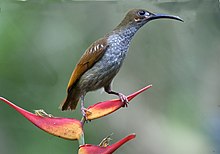| Naked-faced spiderhunter | |
|---|---|

| |
| Scientific classification | |
| Domain: | Eukaryota |
| Kingdom: | Animalia |
| Phylum: | Chordata |
| Class: | Aves |
| Order: | Passeriformes |
| Family: | Nectariniidae |
| Genus: | Arachnothera |
| Species: | A. clarae
|
| Binomial name | |
| Arachnothera clarae | |
.mw-parser-output .hidden-begin{box-sizing:border-box;width:100%;padding:5px;border:none;font-size:95%}.mw-parser-output .hidden-title{font-weight:bold;line-height:1.6;text-align:left}.mw-parser-output .hidden-content{text-align:left}You can help expand this article with text translated from the corresponding article in Swedish. (July 2021) Click [show] for important translation instructions.
Machine translation, like DeepL or Google Translate, is a useful starting point for translations, but translators must revise errors as necessary and confirm that the translation is accurate, rather than simply copy-pasting machine-translated text into the English Wikipedia.
Do not translate text that appears unreliable or low-quality. If possible, verify the text with references provided in the foreign-language article.
You must provide copyright attribution in the edit summary accompanying your translation by providing an interlanguage link to the source of your translation. A model attribution edit summary is Content in this edit is translated from the existing Swedish Wikipedia article at [[:sv:Barkindad spindeljägare]]; see its history for attribution.
You should also add the template ((Translated|sv|Barkindad spindeljägare)) to the talk page.
For more guidance, see Wikipedia:Translation.
The naked-faced spiderhunter (Arachnothera clarae) is a species of bird in the family Nectariniidae. It is endemic to the Philippines.
Its natural habitat is subtropical or tropical moist lowland forests.
